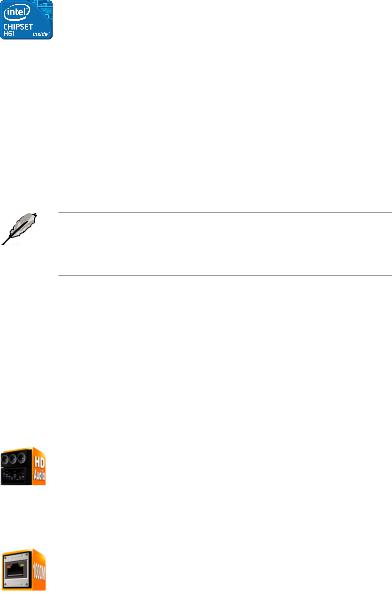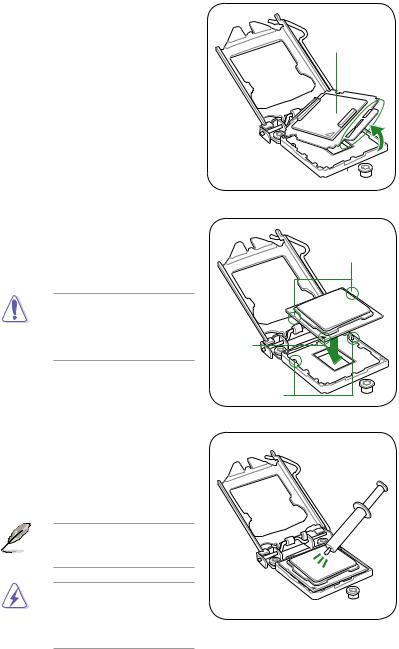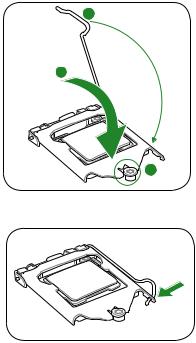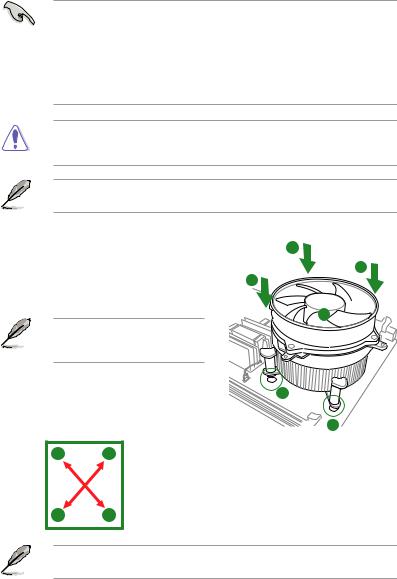Asus P8H61-M LX User Manual

P8H61-M LX R2.0 Series |
Motherboard |
|
• P8H61-M LX R2.0 |
|
|
• P8H61-M PLUS R2.0 |
|
|
|
|
|
|
|
|

E7999
Second Edition
December 2012
Copyright © 2012 ASUSTeK COMPUTER INC. All Rights Reserved.
No part of this manual, including the products and software described in it, may be reproduced, transmitted, transcribed, stored in a retrieval system, or translated into any language in any form or by any means, except documentation kept by the purchaser for backup purposes, without the express written permission of ASUSTeK COMPUTER INC. (“ASUS”).
Product warranty or service will not be extended if: (1) the product is repaired, modified or altered, unless such repair, modification of alteration is authorized in writing byASUS; or (2) the serial number of the product is defaced or missing.
ASUS PROVIDES THIS MANUAL “AS IS” WITHOUT WARRANTY OF ANY KIND, EITHER EXPRESS OR IMPLIED, INCLUDING BUT NOT LIMITED TO THE IMPLIED WARRANTIES OR CONDITIONS OF MERCHANTABILITY OR FITNESS FOR A PARTICULAR PURPOSE. IN NO EVENT SHALL ASUS, ITS DIRECTORS, OFFICERS, EMPLOYEES OR AGENTS BE LIABLE FOR ANY INDIRECT, SPECIAL, INCIDENTAL, OR CONSEQUENTIAL DAMAGES (INCLUDING DAMAGES FOR LOSS OF PROFITS, LOSS OF BUSINESS, LOSS OF USE OR DATA, INTERRUPTION OF BUSINESS AND THE LIKE), EVEN IF ASUS HAS BEEN ADVISED OF THE POSSIBILITY OF SUCH DAMAGES ARISING FROM ANY DEFECT OR ERROR IN THIS MANUAL OR PRODUCT.
SPECIFICATIONS AND INFORMATION CONTAINED IN THIS MANUAL ARE FURNISHED FOR INFORMATIONAL USE ONLY, AND ARE SUBJECT TO CHANGE AT ANY TIME WITHOUT NOTICE, AND SHOULD NOT BE CONSTRUED AS A COMMITMENT BY ASUS. ASUS ASSUMES NO RESPONSIBILITY OR LIABILITY FOR ANY ERRORS OR INACCURACIES THAT MAY APPEAR IN THIS MANUAL, INCLUDING THE PRODUCTS AND SOFTWARE DESCRIBED IN IT.
Products and corporate names appearing in this manual may or may not be registered trademarks or copyrights of their respective companies, and are used only for identification or explanation and to the owners’ benefit, without intent to infringe.
Offer to Provide Source Code of Certain Software
This product contains copyrighted software that is licensed under the General Public License (“GPL”), under the Lesser General Public License Version (“LGPL”) and/or other Free Open Source Software Licenses. Such software in this product is distributed without any warranty to the extent permitted by the applicable law. Copies of these licenses are included in this product.
Where the applicable license entitles you to the source code of such software and/or other additional data, you may obtain it for a period of three years after our last shipment of the product, either
(1)for free by downloading it from http://support.asus.com/download
or
(2)for the cost of reproduction and shipment, which is dependent on the preferred carrier and the location where you want to have it shipped to, by sending a request to:
ASUSTeK Computer Inc.
Legal Compliance Dept.
15 Li Te Rd.,
Beitou, Taipei 112
Taiwan
In your request please provide the name, model number and version, as stated in the About Box of the product for which you wish to obtain the corresponding source code and your contact details so that we can coordinate the terms and cost of shipment with you.
The source code will be distributed WITHOUT ANY WARRANTY and licensed under the same license as the corresponding binary/object code.
This offer is valid to anyone in receipt of this information.
ASUSTeK is eager to duly provide complete source code as required under various Free Open Source Software licenses. If however you encounter any problems in obtaining the full corresponding source code we would be much obliged if you give us a notification to the email address gpl@asus.com, stating the product and describing the problem (please DO NOT send large attachments such as source code archives, etc. to this email address).
ii

Contents
Safety information....................................................................................... |
vi |
About this guide......................................................................................... |
vii |
P8H61-M LX R2.0 Series specifications summary................................... |
ix |
Chapter 1: |
Product introduction |
|
|
1.1 |
Welcome!....................................................................................... |
1-1 |
|
1.2 |
Package contents......................................................................... |
1-1 |
|
1.3 |
Special features............................................................................ |
1-1 |
|
|
1.3.1 |
Product highlights ............................................................ |
1-1 |
|
1.3.2 |
ASUS DIGI+VRM . ........................................................... |
1-3 |
|
1.3.3 |
Innovative ASUS features ................................................ |
1-3 |
1.4 |
Before you proceed...................................................................... |
1-6 |
|
1.5 |
Motherboard overview................................................................. |
1-7 |
|
|
1.5.1 |
Placement direction ......................................................... |
1-7 |
|
1.5.2 |
Screw holes ..................................................................... |
1-7 |
|
1.5.3 |
Motherboard layout .......................................................... |
1-8 |
|
1.5.4 |
Layout contents . .............................................................. |
1-8 |
1.6 |
Central Processing Unit (CPU).................................................... |
1-9 |
|
|
1.6.1 |
Installing the CPU .......................................................... |
1-10 |
|
1.6.2 |
Installing the CPU heatsink and fan .............................. |
1-13 |
|
1.6.3 |
Uninstalling the CPU heatsink and fan .......................... |
1-14 |
1.7 |
System memory.......................................................................... |
1-15 |
|
|
1.7.1 |
Overview ........................................................................ |
1-15 |
|
1.7.2 |
Memory configurations . ................................................. |
1-16 |
|
1.7.3 |
Installing a DIMM ........................................................... |
1-23 |
|
1.7.4 |
Removing a DIMM ......................................................... |
1-23 |
1.8 |
Expansion slots.......................................................................... |
1-24 |
|
|
1.8.1 |
Installing an expansion card .......................................... |
1-24 |
|
1.8.2 |
Configuring an expansion card ...................................... |
1-24 |
|
1.8.3 |
PCI Express 2.0 x1 slots ............................................... |
1-24 |
|
1.8.4 |
PCI Express 3.0/2.0 x16 slot . ........................................ |
1-24 |
1.9 |
Jumpers |
....................................................................................... |
1-25 |
1.10 |
Connectors.................................................................................. |
1-26 |
|
|
1.10.1 .................................................. |
Rear panel connectors |
1-26 |
|
1.10.2 ........................................................ |
Internal connectors |
1-27 |
1.11 |
Software ........................................................................support |
1-32 |
|
iii

Contents
|
1.11.1 |
Installing an operating system....................................... |
1-32 |
|
1.11.2 |
Support DVD information............................................... |
1-32 |
Chapter 2: |
BIOS information |
|
|
2.1 |
Managing and updating your BIOS............................................. |
2-1 |
|
|
2.1.1 |
ASUS Update utility......................................................... |
2-1 |
|
2.1.2 |
ASUS EZ Flash 2............................................................ |
2-2 |
|
2.1.3 |
ASUS CrashFree BIOS 3 utility....................................... |
2-3 |
|
2.1.4 |
ASUS BIOS Updater....................................................... |
2-4 |
2.2 |
BIOS setup program..................................................................... |
2-6 |
|
2.3 |
Main menu................................................................................... |
2-10 |
|
|
2.3.1 |
System Language [English]........................................... |
2-10 |
|
2.3.2 |
System Date [Day xx/xx/xxxx]....................................... |
2-10 |
|
2.3.3 |
System Time [xx:xx:xx].................................................. |
2-10 |
|
2.3.4 |
Security.......................................................................... |
2-10 |
2.4 |
Ai Tweaker menu........................................................................ |
2-13 |
|
|
2.4.1 |
Memory Frequency [Auto]............................................. |
2-14 |
|
2.4.2 |
EPU Power Saving Mode [Disabled]............................. |
2-14 |
|
2.4.3 |
OC Tuner....................................................................... |
2-14 |
|
2.4.4 |
DRAM Timing Control.................................................... |
2-14 |
|
2.4.5 |
CPU Power Management.............................................. |
2-14 |
|
2.4.6 |
DIGI+ VRM.................................................................... |
2-15 |
|
2.4.7 |
CPU Voltage [Offset Mode]............................................ |
2-17 |
|
2.4.8 |
Offset Mode Sign [+]...................................................... |
2-17 |
|
2.4.9 |
iGPU Voltage [Offset Mode]........................................... |
2-17 |
|
2.4.10 |
iGPU Offset Mode Sign [+]............................................ |
2-17 |
|
2.4.11 |
DRAM Voltage [Auto]..................................................... |
2-17 |
|
2.4.12 |
VCCSA Voltage [Auto]................................................... |
2-17 |
|
2.4.13 |
PCH Voltage [Auto]........................................................ |
2-17 |
|
2.4.14 |
CPU PLL Voltage [Auto]................................................ |
2-18 |
2.5 |
Advanced menu.......................................................................... |
2-18 |
|
|
2.5.1 |
CPU Configuration......................................................... |
2-18 |
|
2.5.2 |
PCH Configuration......................................................... |
2-20 |
|
2.5.3 |
SATAConfiguration........................................................ |
2-21 |
|
2.5.4 |
SystemAgent Configuration.......................................... |
2-22 |
|
2.5.5 |
USB Configuration......................................................... |
2-23 |
iv

Contents
|
2.5.6 |
Onboard Devices Configuration.................................... |
2-23 |
|
2.5.7 |
APM............................................................................... |
2-24 |
|
2.5.8 |
Network Stack............................................................... |
2-25 |
2.6 |
Monitor menu.............................................................................. |
2-26 |
|
|
2.6.1 |
CPU Temperature / MB Temperature [xxxºC/xxxºF]...... |
2-26 |
|
2.6.2 |
CPU / Chassis Fan Speed............................................. |
2-26 |
|
2.6.3 |
CPU Q-Fan Control [Enabled]....................................... |
2-26 |
|
2.6.4 |
CPU Fan Speed Low Limit [200 RPM].......................... |
2-27 |
|
2.6.5 |
CPU Voltage, 3.3V Voltage, 5V Voltage, 12V Voltage... |
2-27 |
|
2.6.6 |
Anti Surge Support [Enabled]........................................ |
2-27 |
2.7 |
Boot menu................................................................................... |
2-28 |
|
|
2.7.1 |
Bootup NumLock State [On].......................................... |
2-28 |
|
2.7.2 |
Full Screen Logo [Enabled]........................................... |
2-28 |
|
2.7.3 |
Wait for ‘F1’ If Error [Enabled]....................................... |
2-28 |
|
2.7.4 |
Option ROM Messages [Force BIOS]........................... |
2-29 |
|
2.7.5 |
Setup Mode [EZ Mode].................................................. |
2-29 |
|
2.7.6 |
UEFI/Legacy Boot [Enable both UEFI and Legacy]...... |
2-29 |
|
2.7.7 |
Boot Option Priorities..................................................... |
2-29 |
|
2.7.8 |
Boot Override................................................................ |
2-29 |
2.8 |
Tools menu.................................................................................. |
2-30 |
|
|
2.8.1 |
ASUS EZ Flash Utility.................................................... |
2-30 |
|
2.8.2 |
ASUS SPD Information................................................. |
2-30 |
|
2.8.3 |
ASUS O.C. Profile......................................................... |
2-30 |
2.9 |
Exit menu..................................................................................... |
2-31 |
|
Appendices
Notices....................................................................................................... |
A-1 |
ASUS contact information........................................................................ |
A-3 |

Safety information
Electrical safety
•To prevent electric shock hazard, disconnect the power cable from the electric outlet before relocating the system.
•When adding or removing devices to or from the system, ensure that the power cables for the devices are unplugged before the signal cables are connected. If possible, disconnect all power cables from the existing system before you add a device.
•Before connecting or removing signal cables from the motherboard, ensure that all power cables are unplugged.
•Seek professional assistance before using an adapter or extension cord. These devices could interrupt the grounding circuit.
•Ensure that your power supply is set to the correct voltage in your area. If you are not sure about the voltage of the electrical outlet you are using, contact your local power company.
•If the power supply is broken, do not try to fix it by yourself. Contact a qualified service technician or your retailer.
Operation safety
•Before installing the motherboard and adding components, carefully read all the manuals that came with the package.
•Before using the product, ensure that all cables are correctly connected and the power cables are not damaged. If you detect any damage, contact your dealer immediately.
•To avoid short circuits, keep paper clips, screws, and staple wires away from connectors, slots, sockets, and circuitry.
•Avoid dust, humidity, and extreme temperature. Do not place the product in any area where it may be exposed to moisture.
•Place the product on a stable surface.
•If you encounter technical problems with the product, contact a qualified service technician or your retailer.
vi

About this guide
This user guide contains the information you need when installing and configuring the motherboard.
How this guide is organized
This guide contains the following parts:
•Chapter 1: Product introduction
This chapter describes the supported features of the motherboard.
•Chapter 2: BIOS information
This chapter provides a detailed guide to navigating and setting up the BIOS.
Conventions used in this guide
To ensure that you perform certain tasks properly, take note of the following symbols used throughout this manual.
DANGER/WARNING: Information to prevent injury to yourself when completing a task.
CAUTION: Information to prevent damage to the components when completing a task.
IMPORTANT: Instructions you MUST follow to complete a task.
NOTE: Tips and additional information to help you complete a task.
vii

Where to find more information
Refer to the following sources for additional information and for product and software updates.
1.ASUS websites
The ASUS website provides updated information on ASUS hardware and software products. Refer to the ASUS contact information.
2.Optional documentation
Your product package may include optional documentation, such as warranty flyers, that may have been added by your dealer. These documents are not part of the standard package.
Typography
Bold text |
Indicates a menu or an item to select. |
Italics |
Used to emphasize a word or a phrase. |
<Key> |
Keys enclosed in the less-than and greater-than sign |
|
means that you must press the enclosed key. |
|
Example: <Enter> means that you must press the Enter |
|
or Return key. |
<Key1> + <Key2> + <Key3> |
If you must press two or more keys simultaneously, the |
|
key names are linked with a plus sign (+). Example: |
|
<Ctrl> + <Alt> + <Del> |
viii

P8H61-M LX R2.0 Series specifications summary
CPU |
LGA1155 socket for Intel® Second/Third Generation Core™ i7 / |
|
Core™ i5 / Core™ i3/ Pentium® processors |
|
Supports 32/22nm CPU |
|
Supports Intel® Turbo Boost Technology 2.0* |
|
*The Intel® Turbo Boost Technology 2.0 suppport depends on the |
|
CPU types. |
|
**Refer to www.asus.com for Intel® CPU support list. |
Chipset
Memory
Graphics
Expansion slots
Storage
LAN
Audio
USB
Rear panel ports
Intel® H61 Express Chipset
2 x DIMMs, max. 16GB, DDR3 2200(O.C.) / 2133(O.C.) / 2000(O.
C.) / 1866(O.C.) / 1600 / 1333 / 1066 MHz, non-ECC, un-buffered memory *
Dual-channel memory architecture
Supports Intel® Extreme Memory Profile (XMP)
*DDR3 1600 MHz and higher memory frequency is supported by
Intel® 3rd generation processors.
**Due to the CPU behavior, DDR3 2133/1866 MHz memory module will run at DDR3 2000/1800 MHz frequency.
***Refer to www.asus.com for the latest Memory QVL (Qualified
Vendor List).
****When you install memory of 4GB capacity or more, Windows®
32-bit operating system may only recognize less than 3GB. We recommend a maximum of 3GB system memory if you are using a Windows® 32-bit operating system.
Supports RGB with max. resolution 2048 x1536@75GHz
Intel® Quick Sync Video Technology Support
1 x PCI Express 3.0*/2.0 x16 slot [blue] (at x16 mode) 3 x PCI Express 2.0 x1 slots
*Intel® Third Generation Core™ processors support PCIe 3.0 speed.
Intel® H61 Express Chipset:
- 4 x Serial ATA 3.0 Gb/s connectors
Realtek® 8111E/8111F PCIe Gigabit LAN controller
ALC887 8-channel High DefinitionAudio CODEC
*Use a chassis with HD audio module in the front panel to support an 8-channel audio output.
Intel® H61 Express Chipset:
- 8 x USB 2.0/1.1 ports (4 ports onboard, 4 ports at the back panel)
1 x PS/2 keyboard (purple)
1 x PS/2 mouse (green)
1 x D-Sub port
1 x LAN (RJ-45) port
1 x COM port
1 x LPT port
4 x USB 2.0/1.1 ports (black)
3-Jack 8-channel audio I/O ports
(continued on the next page)
ix

P8H61-M LX R2.0 specifications summary
ASUS unique features ASUS DIGI+VRM
-Digital Power Control: Digital Power Design for the CPU and iGPU
-ASUS 3+1+1 Phase Power Design
ASUS EPU
ASUS Exclusive Overclocking
Internal connectors/ switches/ buttons
BIOS features
Manageability
Accessories
Support DVD
Form factor
- EPU
ASUS Exclusive Features
-Network iControl featuring instant network bandwidth domination for the top network program in use
-AI Suite II
-Anti Surge
-Low EMI Solution
ASUS Quiet Thermal Solution
-ASUS Fanless Design: Stylish heatsink solution
-ASUS Fan Xpert
ASUS EZ DIY
-ASUS UEFI BIOS EZ Mode featuring user-friendly graphics interface
-ASUS CrashFree BIOS 3
-ASUS EZ Flash 2
-ASUS My Logo 2
ASUS C.P.R. (CPU Parameter Recall)
2 x USB 2.0/1.1 connectors support additional 4 USB 2.0/1.1 ports 4 x SATA 3.0 Gb/s connectors
1 x CPU fan connector
1 x Chassis fan connector
1 x Front panel audio connector
1 x S/PDIF Out connector
1 x speaker connector
1 x System panel connector
1 x 24-pin EATX power connector
1 x 4-pin ATX 12V power connector
64 Mb Flash ROM, UEFI AMI BIOS, PnP, DMI v2.0, WfM 2.0, SM BIOS v2.7, ACPI v2.0a, Multi-language BIOS
WfM 2.0, DMI 2.0, WOL by PME, WOR by PME, PXE
2 x Serial ATA 3.0Gb/s cables
1 x I/O shield
1 x User Manual
1 x Support DVD
Drivers
ASUS Utilities
ASUS Update
Anti-virus software (OEM version)
MicroATX form factor: 9.6 in x 7.2 in (24.4 cm x 18.3 cm)
* Specifications are subject to change without notice.

Chapter 1
Product introduction
1.1Welcome!
Thank you for buying an ASUS® P8H61-M LX R2.0 Series motherboard!
The motherboard delivers a host of new features and the latest technologies, making it another standout in the long line of ASUS quality motherboards!
Before you start installing the motherboard and adding components, check the items in your package with the list below.
1.2Package contents
Check your motherboard package for the following items.
Motherboard |
ASUS P8H61-M LX 2.0 Series motherboard |
Cables |
2 x Serial ATA 3.0Gb/s cables |
Accessories |
1 x I/O shield |
Application DVD |
ASUS motherboard support DVD |
Documentation |
User Manual |
If any of the above items is damaged or missing, contact your retailer.
1.3Special features
1.3.1Product highlights
Intel® LGA1155 Intel® Second Generation Core™ i7 / Core™ i5 / Core™ i3 processors
This motherboard supports the Intel® second generation Core™ i7 / Core™ i5 / Core™ i3 processors in LGA1155 package with memory and PCI Express controllers integrated to support 2-channel (2 DIMMs) DDR3 memory and 16 PCI Express 2.0 lanes. This provides great graphics performance. Intel® second generation Core™ i7 / Core™ i5 / Core™ i3 processors are among the most powerful and energy efficient CPUs in the world.
Chapter 1: Product introduction |
1-1 |

Intel® H61 Express Chipset
The Intel® H61 Express Chipset is the latest single-chipset design to support the new 1155 socket Intel® Core™ i7 / Core™ i5 / Core™ i3 second generation processors. It provides improved performance by utilizing serial point-to-point links, which allows increased bandwidth and stability.
Dual-Channel DDR3 2200(O.C.) / 2133 (O.C.) / 2000 (O.C.) / 1866 (O.C.) / 1600 / 1333 / 1066MHz support
The motherboard supports DDR3 memory that features data transfer rates of 2200 (O.C.) / 2133 (O.C.) / 2000 (O.C.) / 1866 (O.C.) / 1600 /
1333 / 1066MHz to meet the higher bandwidth requirements of the latest
3D graphics, multimedia, and Internet applications. The dual-channel DDR3 architecture enlarges the bandwidth of your system memory to boost system performance.
•DDR3 1600 MHz and higher memory frequency is supported by Intel® 3rd generation processors.
•Due to the CPU behavior, DDR3 2133/1866 memory modules will run at DDR3
2000/1800 MHz frequency.
PCI Express® 3.0
PCI Express® 3.0 (PCIe 3.0) is the latest PCI Express bus standard with improved encoding schemes that provide twice the performance of the current PCIe 2.0. The total bandwidth for a x16 link reaches a maximum of 32Gb/s, double the 16 Gb/s of PCIe 2.0 (in x16 mode). As such, PCIe 3.0 provides users unprecendented data speeds, combined with the convenience and seamless transition offerred by complete backward compatibility with PCIe 1.0 and PCIe 2.0 devices. PCIe 3.0 will become a must-have feature for users who wish to improve and optimize graphic performance, as well as have the latest technology available to them.
* PCI 3.0 speed is supported by Intel® 3rd generation Core™ processors.
8-channel high definition audio
The onboard 8-channel HD audio (High DefinitionAudio, previously codenamedAzalia) CODEC enables high-quality 192KHz/24-bit audio output and jack-detect feature that automatically detects and identifies what types of peripherals are plugged into the audio I/O jacks and notifies users of inappropriate connection, which means there will be no more confusion of Line-in, Line-out, and Mic jacks.
Gigabit LAN solution
The onboard LAN controller is a highly integrated Gb LAN controller. It is enhanced with anACPI management function to provide efficient power management for advanced operating systems.
1-2 |
ASUS P8H61-M LX R2.0 |

100% All High-quality Conductive Polymer Capacitors (P8H61-M LX R2.0 PLUS R2.0 only)
This motherboard uses all high-quality conductive polymer capacitors for durability, improved lifespan, and enhanced thermal capacity.
1.3.2ASUS DIGI+VRM
Digital Power Control: Digital Power Design for the CPU and iGPU
All-new digital CPU power controls work perfectly together to match digital power signal (SVID) requests from the CPU, with ultra-fast sensing and response efficiently delivering precision power.Accurate delivery reduces waste, and provides more stable CPU Vcore voltages. Users can adjust the CPU and its prcoessor graphics (iGPU) voltages for various overclocking scenarios, with accurate input through UEFI BIOS tuning or the exclusive ASUS interface. This proprietary design increases overclocking headroom to push performance to its full potential.
ASUS EPU
Tap into the world’s first real-time PC power saving chip through a simple oboard switch or AI Suite II utility. Get total system-wide energy optimization by automatically detecting current PC loadings and intelligently moderating power consumption. This also reduces fan noise and extends component longevity.
1.3.3Innovative ASUS features
ASUS UEFI BIOS (EZ Mode)
The newASUS UEFI BIOS is an Unified Extensible Firmware Interface that offers a user-friendly interface that goes beyond traditional keyboardonly BIOS control to enable more flexible and convenient mouse input.
Users can easily navigate the new UEFI BIOS with the same smoothness as their operating system. It natively supports hard drives larger than
2.2TB in 64-bit, with full storage space utilization, helping deliver far more exciting computing than traditional BIOS version. The exclusive EZ Mode displays frequently-accessed setup info. while the Advanced Mode is
for experienced performance enthusiasts that demand far more intricate system settings.
Chapter 1: Product introduction |
1-3 |

ASUS Anti-Surge Protection
This special design prevents expensive devices and the motherboard from damage caused by power surges from switching power supply (PSU).
AI Suite II
With its fast user-friendly interface, ASUS AI Suite II consolidates all the exclusive ASUS features into one simple to use software package. It allows you to supervise overclocking, energy management, fan speed control, and voltage and sensor readings. This all-in-one software offers diverse and ease to use functions, with no need to switch back and forth between different utilities.
Fanless Design: stylish heatsink solution
The stylish heatsink features a 0-dB thermal solution that offers users a noiseless PC environment. The beautiful shape of the heatsink design not only provides visual enjoyment for motherboard users, but also lowers the temperature of the chipset and power phase area through high efficient heat-exchange. Combining usability and aesthetics, the ASUS stylish heatpipe will give users an extremely silent and cooling experience with an elegant appearance!
ESD
Protect Your Computer with ESD Guards. Electrostatic discharge (ESD) conditions can happen while plugging or unplugging any USB peripherals-causing damage to the computer. ASUS ESD Guards clamp the ESD voltage and shunt the majority of the ESD current away for a more reliable computing environment.
Low EMI
A special low-radiation design shields you from harmful electromagnetic exposure by eliminating 50% of radiation.
1.Radiation Deduction Design minimizes harmful electromagnetic radiation output with exclusive circuit design to cancel electrical charge.
2.The Radiation Moat Design effectively blocks radiation to prevent discharge spread.
Fan Xpert
ASUS Fan Xpert intelligently allows you to adjust the CPU fan speed according to different ambient temperatures caused by different climate conditions in different geographic regions and your PC’s loading. The built-in variety of useful profiles offer flexible controls of fan speed to achieve a quiet and cool environment.
ASUS MyLogo2™
This feature allows you to convert your favorite photo into a 256-color boot logo for a more colorful and vivid image on your screen.
1-4 |
ASUS P8H61-M LX R2.0 |

ASUS CrashFree BIOS 3
ASUS CrashFree BIOS 3 is an auto-recovery tool that allows you to restore a corrupted BIOS file using the bundled support DVD or USB flash disk that contains the latest BIOS file.
ASUS EZ Flash 2
ASUS EZ Flash 2 is a utility that allows you to update the BIOS without using an OS-based utility.
C.P.R. (CPU Parameter Recall)
The BIOS C.P.R. feature automatically restores the CPU default settings when the system hangs due to overclocking failure. C.P.R. eliminates the need to open the system chassis and clear the RTC data. Simply shut down and reboot the system, and the BIOS automatically restores the CPU parameters to their default settings.
ErP ready
The motherboard is European Union´s Energy-related Products (ErP) ready, and ErP requires products to meet certain energy efficiency requirements in regards to energy consumptions. This is in line with
ASUS vision of creating environment-friendly and energy-efficient products through product design and innovation to reduce carbon footprint of the product and thus mitigate environmental impacts.
Chapter 1: Product introduction |
1-5 |

1.4Before you proceed
Take note of the following precautions before you install motherboard components or change any motherboard settings.
• Unplug the power cord from the wall socket before touching any component.
• Before handling components, use a grounded wrist strap or touch a safely grounded object or a metal object, such as the power supply case, to avoid damaging them due to static electricity.
•Hold components by the edges to avoid touching the ICs on them.
•Whenever you uninstall any component, place it on a grounded antistatic pad or in the bag that came with the component.
•Before you install or remove any component, ensure that the ATX power supply is switched off or the power cord is disconnected from the power supply. Failure to do so may cause severe damage to the motherboard, peripherals, or components.
Standby Power LED
The motherboard comes with a standby power LED that lights up to indicate that the system is ON, in sleep mode, or in soft-off mode. This is a reminder that you should shut down
the system and unplug the power cable before removing or plugging in any motherboard component. The illustration below shows the location of the onboard LED.
SB_PWR
P8H61-M LX R2.0
ON OFF
 Standby Power Powered Off
Standby Power Powered Off
P8H61-M LX R2.0 Onboard LED
1-6 |
ASUS P8H61-M LX R2.0 |

1.5Motherboard overview
Study the configuration of your chassis to ensure that the motherboard fits before installing the motherboard.
Ensure that you unplug the power cord before installing or removing the motherboard. Failure to do so can cause you physical injury and damage motherboard components.
1.5.1Placement direction
When installing the motherboard, ensure that you place it into the chassis in the correct orientation. The edge with external ports goes to the rear part of the chassis as indicated in the image below.
1.5.2Screw holes
Secure the motherboard to the chassis using six screws as indicated by the circles in the illustration below.
Do not overtighten the screws! Doing so can damage the motherboard.
Place this side towards |
the rear of the chassis |
P8H61-M LX R2.0
|
|
|
|
|
|
|
|
|
|
|
|
|
|
|
|
|
|
|
|
|
|
|
|
|
|
|
|
|
|
|
|
|
|
|
|
|
|
|
|
|
|
|
|
|
|
|
|
|
|
|
|
|
|
|
|
|
|
|
|
|
|
|
|
|
|
|
|
|
|
|
|
|
|
|
|
|
|
|
|
|
|
|
|
|
|
|
|
|
|
|
|
|
|
|
|
|
|
|
|
|
|
|
|
|
|
|
|
|
|
|
|
|
|
|
|
|
|
|
|
|
|
|
|
|
|
|
|
|
|
|
|
|
|
|
|
|
|
|
|
|
|
|
|
|
|
|
|
|
|
|
|
|
|
|
|
|
|
|
|
|
|
|
|
|
|
|
|
|
|
|
|
|
|
|
|
|
|
|
|
|
|
|
|
|
|
|
|
|
|
|
|
|
|
|
|
|
|
|
|
|
|
|
|
|
|
|
|
|
|
|
|
|
|
|
|
|
|
|
|
|
|
|
|
|
|
|
|
|
|
|
|
|
|
|
|
|
|
|
|
|
|
|
|
|
|
|
|
|
|
|
|
|
|
|
|
|
|
|
|
|
|
|
|
|
|
|
|
|
|
|
|
|
|
|
|
|
|
|
|
|
|
|
|
|
|
|
|
Chapter 1: Product introduction |
1-7 |
||||||||||||||||

1.5.3Motherboard layout
1 |
2 |
3 |
1 |
|
4 |
|
||
|
|
18.3cm(7.2in) |
|
|
|
|
|
|
|
|
|
|
|
|
|
|
|
|
|
|
|
|
|
|
|
|
|
|
|
|
|
|
|
|
|
|
KBMS |
|
DIGI |
|
|
CPU_FAN |
|
|
|
|
|
|
|
|
|
|
|
|
|
|
|
|
|
|
|
|
|
|
|
|
+VRM |
|
|
|
|
|
|
|
|
|
|
|
COM |
ATX12V |
|
|
|
|
|
|
|
|
|
|
|
|
|
|
|
|
|
|
|
|
|
|
|
||
|
LPT |
|
|
|
|
|
|
module) |
|
module) |
|
|
|
|
VGA |
|
|
LGA1155 |
|
|
|
(64bit, 240-pin |
|
(64bit, 240-pin |
|
|
|
|
USB34 |
|
|
|
|
|
|
A1 |
|
B1 |
|
|
|
|
|
|
|
|
|
|
DDR3DIMM |
|
DDR3DIMM |
|
24.4cm(9.6in) |
|
|
|
LAN1_USB12 |
|
|
|
|
|
|
EATXPWR |
|
||||
|
|
RTL |
|
Lithium Cell |
|
|
|
|
|
|
|
|
2 |
|
|
8111E/ |
|
|
|
|
|
|
|
|
|
||
|
|
8111F |
|
CMOS Power |
|
|
|
|
|
|
|
|
|
|
|
|
CHA_FAN |
|
|
|
|
|
|
|
|
||
|
AUDIO |
|
|
|
|
|
|
|
|
|
|
|
|
|
|
|
|
|
|
|
|
|
|
|
|
|
|
|
|
|
|
PCIEX16 |
|
|
|
|
|
|
|
|
|
|
|
|
|
P8H61-M LX R2.0 |
|
|
|
|
|
||||
|
|
Super |
PCIEX1_1 |
|
|
|
|
|
|
|
|
|
|
|
|
I/O |
|
|
|
|
|
|
|
|
|
|
|
|
|
|
|
|
|
|
Intel® |
SATA3G_2 |
SATA3G_1 |
|
|
||
|
|
|
PCIEX1_2 |
|
|
|
H61 |
|
|
|
|
|
|
|
|
|
|
|
|
|
|
SATA3G_4 |
SATA3G_3 |
|
5 |
||
|
|
|
|
|
|
|
|
|
|
||||
|
|
|
PCIEX1_3 |
|
|
|
|
|
|
|
|
|
6 |
|
ALC |
SPDIF_OUT |
|
|
|
|
|
|
8Mb |
|
|
|
|
|
887 |
|
USB56 |
USB78 |
|
|
F_PANEL |
BIOS |
|
|
|
||
|
|
|
|
|
CLRTC |
|
SB_PWR |
|
|||||
|
AAFP |
|
|
|
|
SPEAKER |
|
SPEAKER |
|
|
|||
|
|
|
|
|
|
|
|
|
|
|
|
||
|
|
12 |
11 |
10 |
|
9 |
8 |
7 |
|
|
|
|
|
1.5.4 |
Layout contents |
|
|
|
|
|
|
|
|
|
|||
|
Connectors/Jumpers/Slots/LED |
Page |
|
Connectors/Jumpers/Slots/LED |
Page |
1. |
CPU and chassis fan connectors |
1-23 |
7. |
System panel connector (10-1 pin F-PANEL) |
1-25 |
|
(4-pin CPU_FAN, 3-pin CHA_FAN) |
|
|
|
|
2. |
ATX power connectors (24-pin EATXPWR, |
1-22 |
8. |
Speaker connector (4-pin SPEAKER) |
1-22 |
|
4-pin ATX12V) |
|
|
|
|
3. |
Intel® LGA1155 CPU socket |
1-8 |
9. |
Clear RTC RAM (3-pin CLRTC) |
1-19 |
4. |
DDR3 DIMM slots |
1-13 |
10. USB connectors (10-1 pin USB56, USB78) |
1-23 |
|
5. |
Intel® H61 Serial ATA 3.0Gb/s connectors |
1-24 |
11. |
Digital audio connector (4-1 pin SPDIF_OUT) |
1-24 |
|
(7-pin SATA3G_1/2/3/4) |
|
|
|
|
6. |
Standby power LED (SB_PWR) |
1-1 |
12. |
Front panel audio connector (10-1 pin AAFP) |
1-21 |
1-8 |
ASUS P8H61-M LX R2.0 |

1.6Central Processing Unit (CPU)
The motherboard comes with a surface mount LGA1155 socket designed for the Intel® Second Generation Core™ i7 / Core™ i5 / Core™ i3 processors.
P8H61-M LX R2.0
P8H61-M LX R2.0 CPU socket LGA1155
Unplug all power cables before installing the CPU.
• Upon purchase of the motherboard, ensure that the PnP cap is on the socket and the socket contacts are not bent. Contact your retailer immediately if the PnP cap is missing, or if you see any damage to the PnP cap/socket contacts/motherboard components. ASUS will shoulder the cost of repair only if the damage is shipment/ transit-related.
•Keep the cap after installing the motherboard. ASUS will process Return Merchandise
Authorization (RMA) requests only if the motherboard comes with the cap on the
LGA1155 socket.
•The product warranty does not cover damage to the socket contacts resulting from incorrect CPU installation/removal, or misplacement/loss/incorrect removal of the PnP cap.
Chapter 1: Product introduction |
1-9 |

1.6.1Installing the CPU
To install a CPU:
1.Locate the CPU socket on the motherboard.
P8H61-M LX R2.0
P8H61-M LX R2.0 CPU socket LGA1155
2.Press the load lever with your thumb (A), and then move it to the right (B) until it is released from the retention tab.
To prevent damage to the socket pins, do not remove the PnP cap unless you are installing a CPU.
3.Lift the load lever in the direction of the arrow until the load plate is completely lifted.
Load lever
B
Retention tab
1-10 |
ASUS P8H61-M LX R2.0 |

4.Remove the PnP cap from the CPU socket by lifting the tab only.
5.Position the CPU over the socket, ensuring that the gold triangle is on the bottom left corner of the socket, and then fit the socket alignment keys into the CPU notches.
The CPU fits in only one correct orientation. DO NOT force the CPU into the socket to prevent bending the connectors on the socket and damaging the CPU!
6.Apply some Thermal Interface Material to the exposed area of the CPU that the heatsink will be in contact with, ensuring that it is spread in an even thin layer.
Some heatsinks come with preapplied thermal paste. If so, skip this step.
The Thermal Interface Material is toxic and inedible. DO NOT eat it. If it gets into your eyes or touches your skin, wash it off immediately, and seek professional medical help.
PnP cap
CPU notches
Gold |
triangle |
mark |
Alignment keys |
Chapter 1: Product introduction |
1-11 |

7.Close the load plate (A), and then push down the load lever (B), ensuring that the front edge of the load plate slides under the retention knob (C).
B
A
C |
8.Insert the load lever under the retention tab.
1-12 |
ASUS P8H61-M LX R2.0 |

1.6.2Installing the CPU heatsink and fan
The Intel® LGA1155 processor requires a specially designed heatsink and fan assembly to ensure optimum thermal condition and performance.
• When you buy a boxed Intel® processor, the package includes the CPU fan and heatsink assembly. If you buy a CPU separately, ensure that you use only Intel® certified multi directional heatsink and fan.
•Your Intel® LGA1155 heatsink and fan assembly comes in a push-pin design and requires no tool to install.
•Use a LGA1155-compatible CPU heatsink and fan assembly only. The LGA1155 socket is incompatible with the LGA775 and LGA1366 sockets in size and dimension.
If you purchased a separate CPU heatsink and fan assembly, ensure that you have properly applied Thermal Interface Material to the CPU heatsink or CPU before you install the heatsink and fan assembly.
Ensure that you have installed the motherboard to the chassis before you install the CPU fan and heatsink assembly.
To install the CPU heatsink and fan:
1.Place the heatsink on top of the installed CPU, ensuring that the four fasteners match the holes on the motherboard.
Orient the heatsink and fan assembly such that the CPU fan cable is closest to the CPU fan connector.
2.Push down two fasteners at a time in a diagonal sequence to secure the heatsink and fan assembly in place.
AB
BA
A
B
B
A

1
1
The type of CPU heatsink and fan assembly may differ, but the installation steps and functions should remain the same. The illustration above is for reference only.
Chapter 1: Product introduction |
1-13 |

3.Connect the CPU fan cable to the connector on the motherboard labeled CPU_FAN.

 CPU_FAN
CPU_FAN
P8H61-M LX R2.0
CPU FAN PWM CPU FAN IN CPU FAN PWR GND
P8H61-M LX R2.0 CPU fan connector
Do not forget to connect the CPU fan connector! Hardware monitoring errors can occur if you fail to plug this connector.
1.6.3Uninstalling the CPU heatsink and fan
To uninstall the CPU heatsink and fan:
1.Disconnect the CPU fan cable from the connector on the motherboard.
2.Rotate each fastener counterclockwise.
3.Pull up two fasteners at a time in a diagonal sequence to disengage the heatsink and fan assembly from the motherboard.
A
B
|
A |
B |
B |
|
B |
A |
A |
|
1-14 |
ASUS P8H61-M LX R2.0 |
